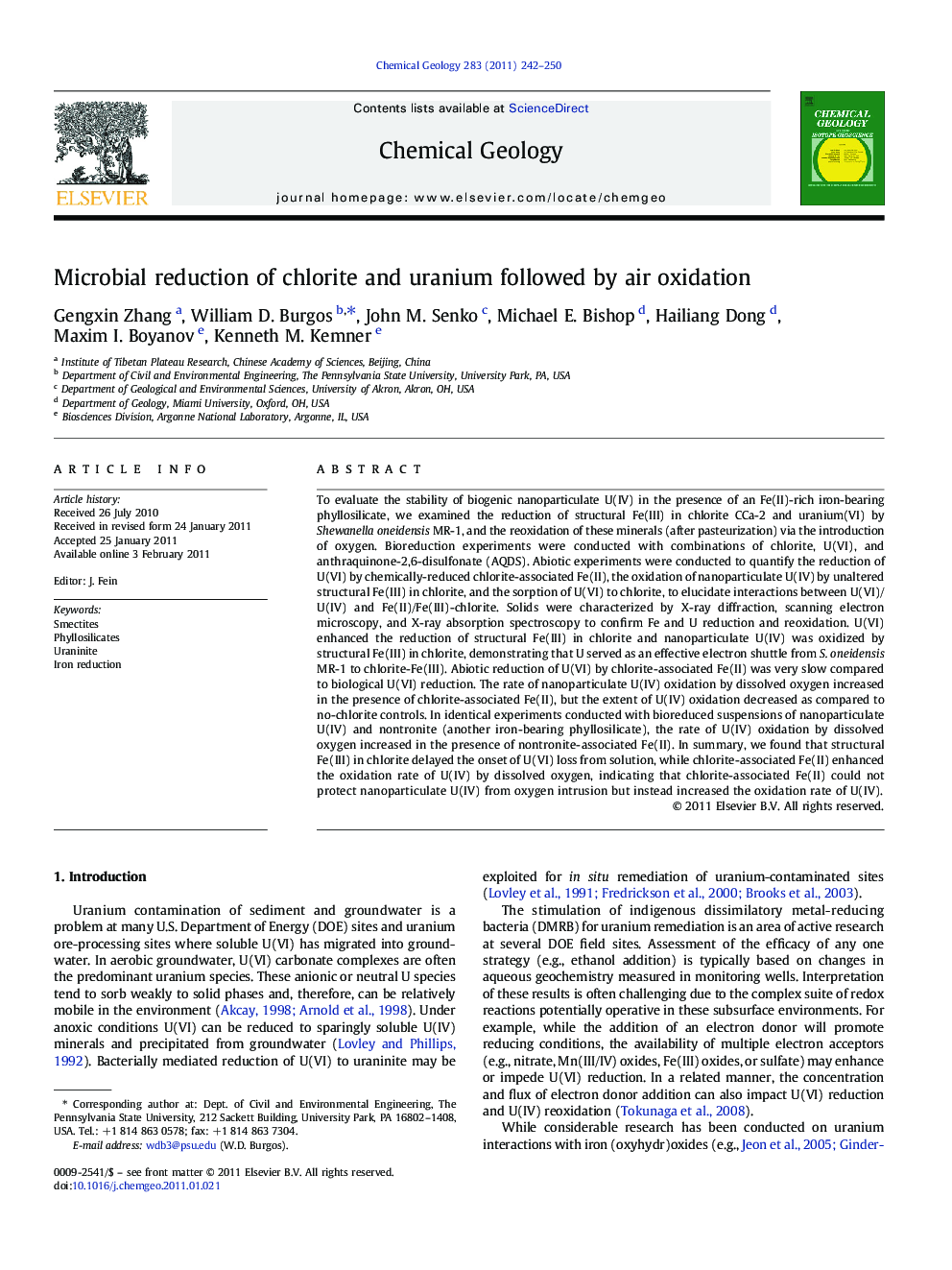| کد مقاله | کد نشریه | سال انتشار | مقاله انگلیسی | نسخه تمام متن |
|---|---|---|---|---|
| 4699768 | 1637669 | 2011 | 9 صفحه PDF | دانلود رایگان |

To evaluate the stability of biogenic nanoparticulate U(IV) in the presence of an Fe(II)-rich iron-bearing phyllosilicate, we examined the reduction of structural Fe(III) in chlorite CCa-2 and uranium(VI) by Shewanella oneidensis MR-1, and the reoxidation of these minerals (after pasteurization) via the introduction of oxygen. Bioreduction experiments were conducted with combinations of chlorite, U(VI), and anthraquinone-2,6-disulfonate (AQDS). Abiotic experiments were conducted to quantify the reduction of U(VI) by chemically-reduced chlorite-associated Fe(II), the oxidation of nanoparticulate U(IV) by unaltered structural Fe(III) in chlorite, and the sorption of U(VI) to chlorite, to elucidate interactions between U(VI)/U(IV) and Fe(II)/Fe(III)-chlorite. Solids were characterized by X-ray diffraction, scanning electron microscopy, and X-ray absorption spectroscopy to confirm Fe and U reduction and reoxidation. U(VI) enhanced the reduction of structural Fe(III) in chlorite and nanoparticulate U(IV) was oxidized by structural Fe(III) in chlorite, demonstrating that U served as an effective electron shuttle from S. oneidensis MR-1 to chlorite-Fe(III). Abiotic reduction of U(VI) by chlorite-associated Fe(II) was very slow compared to biological U(VI) reduction. The rate of nanoparticulate U(IV) oxidation by dissolved oxygen increased in the presence of chlorite-associated Fe(II), but the extent of U(IV) oxidation decreased as compared to no-chlorite controls. In identical experiments conducted with bioreduced suspensions of nanoparticulate U(IV) and nontronite (another iron-bearing phyllosilicate), the rate of U(IV) oxidation by dissolved oxygen increased in the presence of nontronite-associated Fe(II). In summary, we found that structural Fe(III) in chlorite delayed the onset of U(VI) loss from solution, while chlorite-associated Fe(II) enhanced the oxidation rate of U(IV) by dissolved oxygen, indicating that chlorite-associated Fe(II) could not protect nanoparticulate U(IV) from oxygen intrusion but instead increased the oxidation rate of U(IV).
Research highlights
► Chlorite-Fe(III) delayed U(VI) reduction, while chlorite-Fe(II) enhanced U(IV) oxidation.
► U(VI) reduced chlorite-Fe(III) while U(IV) oxidized chlorite-Fe(II).
► Chlorite-Fe(II) could not protect U(IV) from oxygen intrusion.
► Abiotic reduction of U(VI) by chlorite-Fe(II) was slow compared to U(VI) bioreduction.
► U(IV) oxidation by dissolved oxygen also increased in the presence of nontronite-Fe(II).
Journal: Chemical Geology - Volume 283, Issues 3–4, 22 April 2011, Pages 242–250